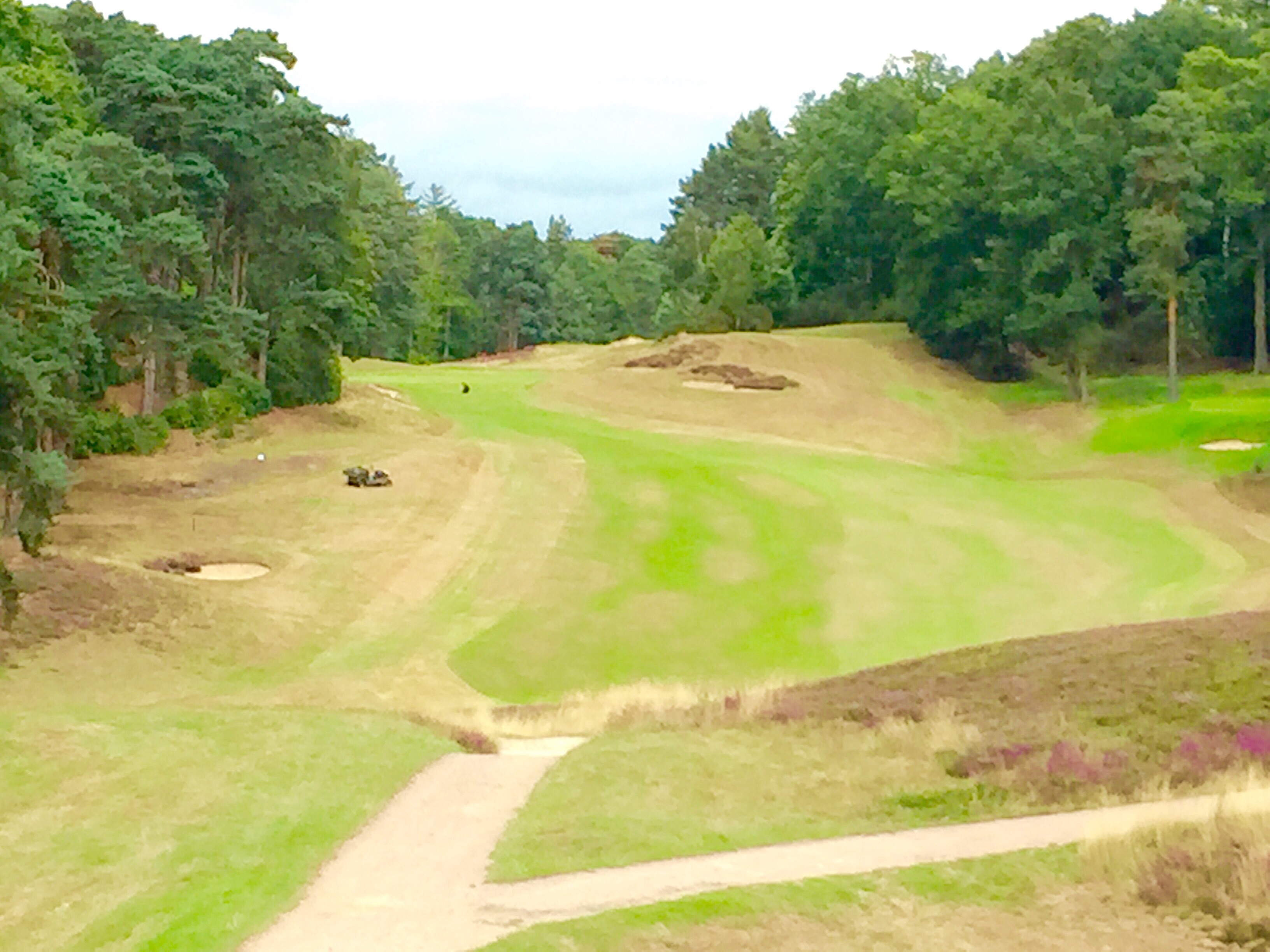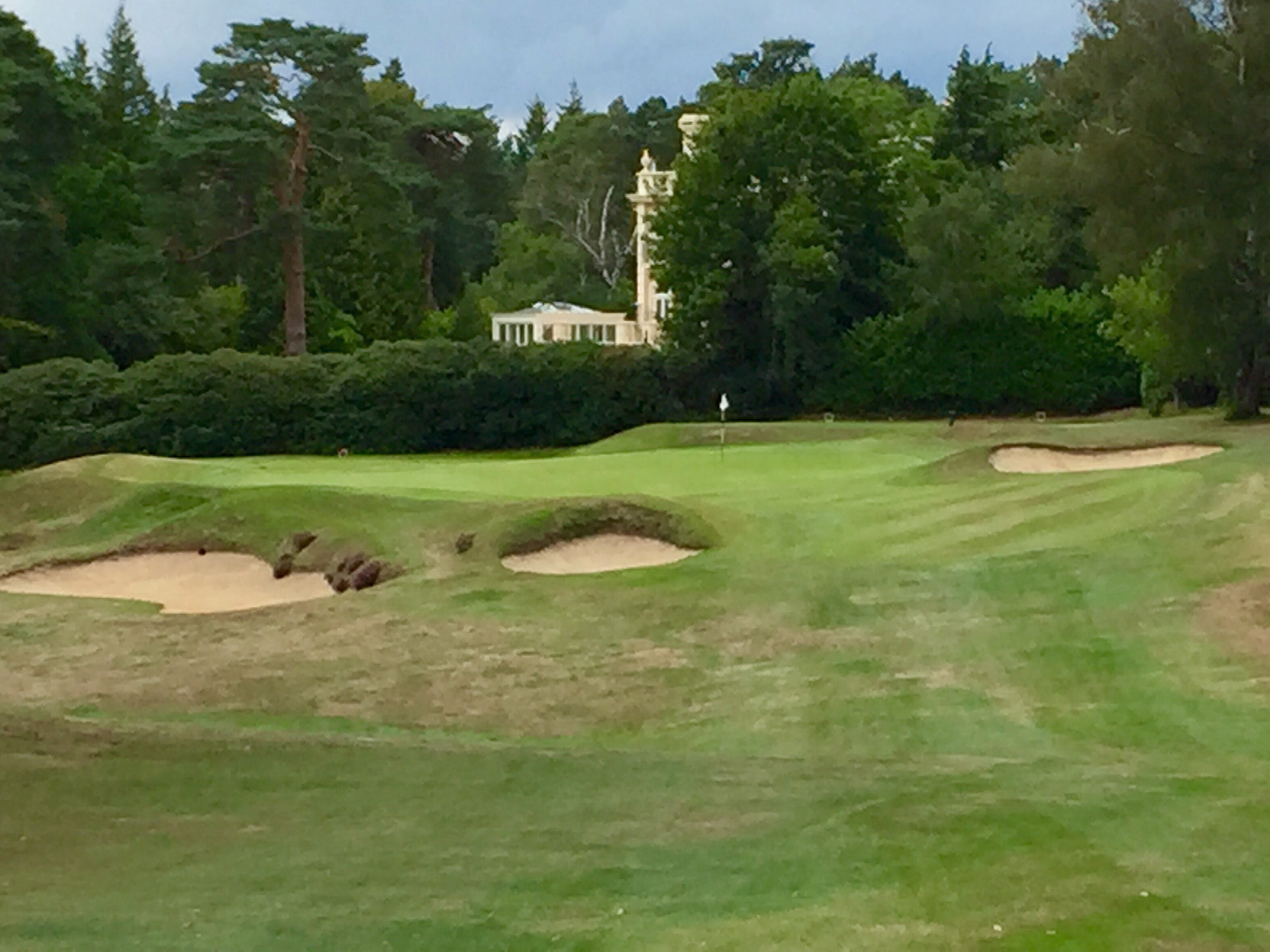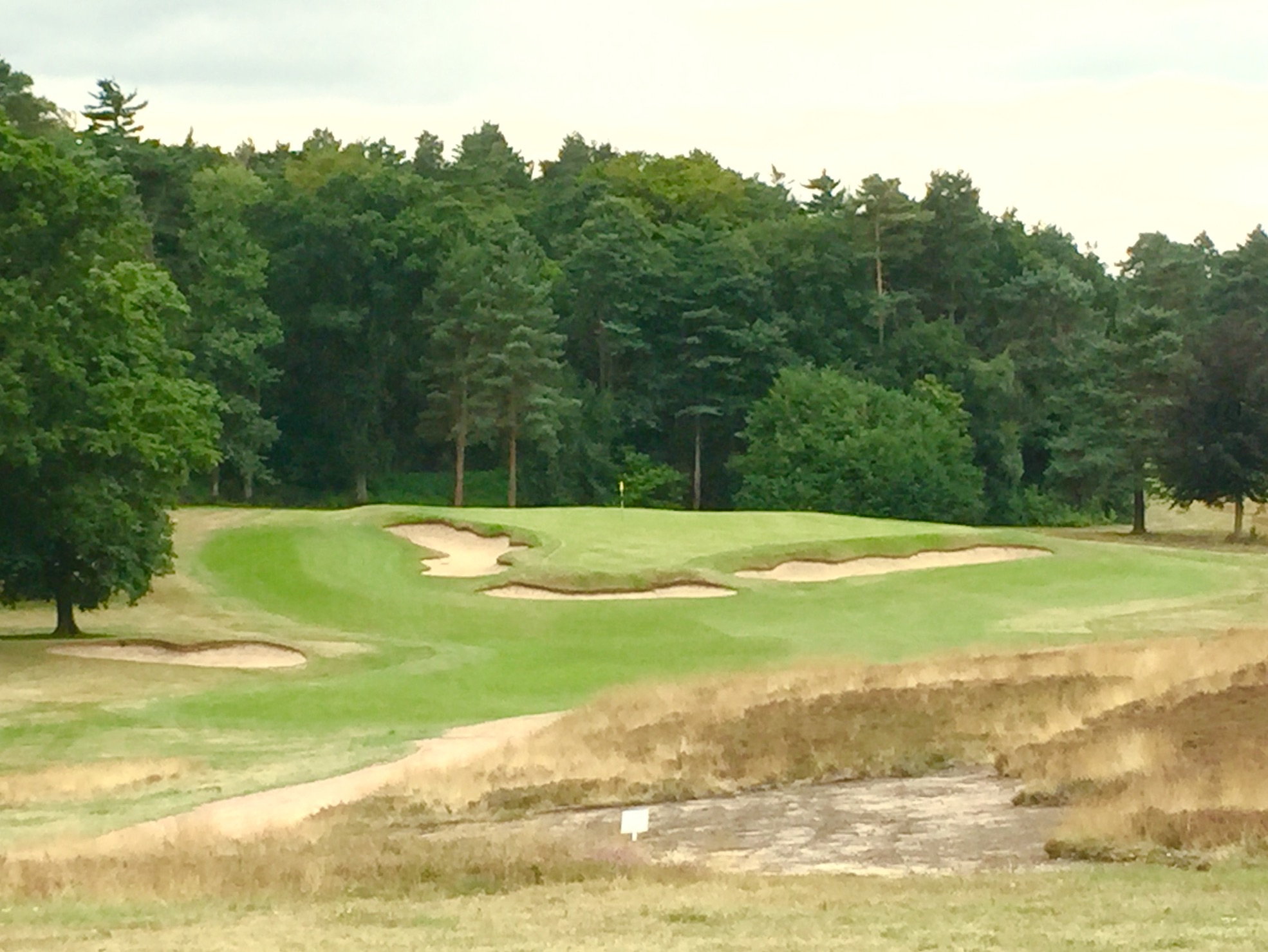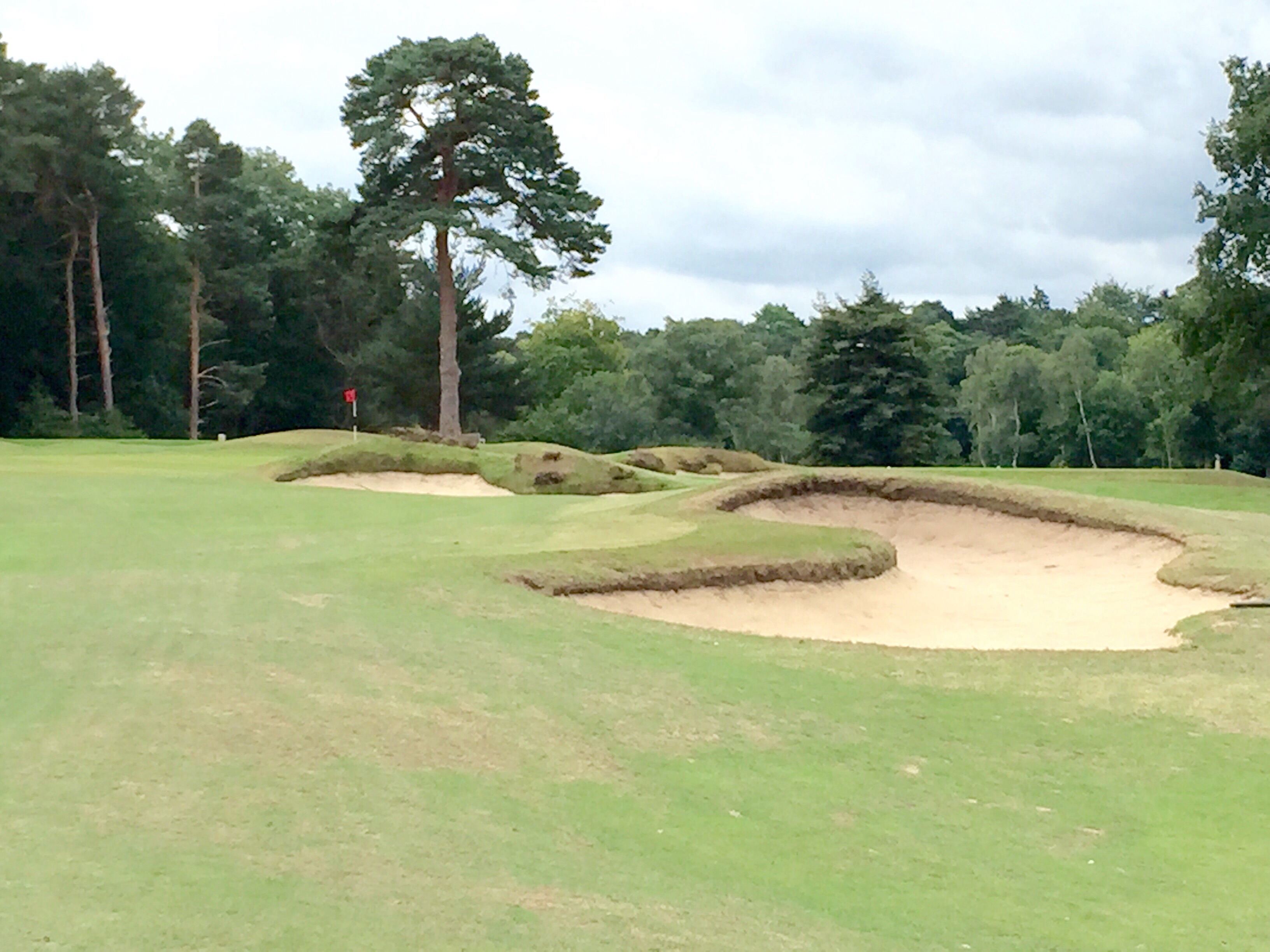The huge, hulking castle of a clubhouse at St. Georges Hill Golf Club southwest of London offers no shelter from the storm. It began to rain just after our round, and it was impossible to find a dry place to store our clubs outside while we had a post-game brew in the comfortable clubhouse bar. Even huddled against the side of the massive structure, the water rained down on the clubs. But like everything else at this 102-year old club, accommodations are made: We were invited to store our clubs on a wooden indoor rack spread along a hallway leading toward the inner sanctum of the clubhouse.
The par 4 1st hole at St. Georges Hill in Weybridge, England.
There is no shelter on the golf course either; quite the opposite actually, given all the heather and gorse. You can really use a drink after a first round at St. Georges Hill, which tests most shots in the bag, even though it plays to a rather modest length of 6,324 yards from the tees I played and just 6,541 from the tees my son Tim played. This is typical British heathland golf, which is to say up and down, with plenty of bunkers; and the bunkers, in this case, are fringed in beautiful purple flowers indicative of the ugly gorse bushes below. In typical States golf, you clear a bunker and you are relieved; here, clearing a fairway bunker might lead to a worse fate. If you are lucky enough to find your ball in the gnarly gorse, best of luck plowing through the stuff with any club. The medicine you take is often a stroke for an unplayable lie. Tim referred to the beautifully deadly gorse as the Purple People Eater. It is hungry stuff.
One of the mansions beside the golf course peeks out from behind the par 3 3rd hole.
All the holes at St. Georges Hill are memorable. Take any hole on the course and plop it onto a layout any of us play regularly and it would stand out. The first hole, for example, is a par four which plays down to a fairway that narrows as it makes its way back up to the green which, itself, is half hidden by a hillside. You are blind to the green, which is to say that first timers will guess at how far front or back the pin is (in our case, up front but that wasn’t much help in guessing at the distance from mid fairway, even with sprinkler-head yardages). In any case, the green was just deep enough to accommodate a well struck, if longer-than-necessary, iron approach. A wonderful starting hole. (By the way, the distances on sprinkler heads are to the front of greens rather than the middle, which I found helpful; the flagsticks are color coded for their positions on the greens, and since it was madness to try to hit approaches to the stick, the front edge was essentially where most shots should be played.)
A classic short -- very short -- par 4, the 4th at St. Georges requires a drive 240 yards or so in the air or a layup with an eight iron or less.
St. Georges was rated by Golf Digest in 2014 as the 77th best golf course in the world and in the top 25 of all British Isles courses in recent years by Golf Monthly and Golf World. Unlike handicap ratings for many American courses, the Royal & Ancient surveyors of courses in the UK give a fair nod to challenging par 3s and are not deferential to distance. For that reason, the par 3s at St. Georges stand out as among the best collections anywhere, rivals for those at Pine Valley or Augusta National. The first one-shotter you encounter at St. Georges is the 3rd hole, at 198/178 yards respectively from the white and yellow tees, a downhiller with four bunkers at greenside and only the narrowest of entryways at the right front. Peeking out from behind the evergreens behind the green is a huge estate home, one of many dotting the course but at a distance. The 3rd green is banked from back to front, and we caught probably the easiest pin position on the green, middle right but far enough up the slope to make any play beyond the pin a deadly affair.
The approach to #7 at St. Georges is best made from the left side lest menacing bunkers and a greenside tree that appears, from some angles, to front the green affect the shot.
The 8th is a wondrous par 3 (179/173 yards), another downhiller, the crater-like greenside bunkers looking a bit lunar. The three in front are pulled well away from the green – about 15 yards – and the fourth, at left, is at some remove from most pin positions and only a magnet for severely pulled shots. The position of the bunkers and the wide green give the impression of a rather easy hole (as does its scorecard handicap of 15), but the green slopes upward from front right to rear left, and shots left more than 25 feet away are in three-putt territory.
The 11th is the first par 3 that is uphill, and needs to be since it is a mere 119 yards from the tips and 107 yards from the yellows. It earns the easiest hole rating on the card but still carries a challenge since there are two menacing front bunkers behind which any mischievous greenskeeper would be proud to place the pin. On our day, the pin was behind the left front bunker and forced a conservative wedge to the middle of the green, a good 15 to 20 feet away from the hole.
The purple topped gorse is ornamental at tee boxes but the stuff is lethal around bunkers and off the fairways at St. Georges. The bunkers themselves are brutal too.
The final par 3 of the round, #14, is the longest at 211/199 yards and forces a solidly struck tee shot lest the yellow-staked ditch about 40 yards short, or the gorse just beyond it, gobble up any skulled or skied shot. A smallish bunker right and a huge one arcing around the left side of the green will snare an offline shot. The only proper landing area is just short and mid green, from where you are bound to have a longish birdie putt unless the greenskeeper has seen fit to place the hole at center green.
The Ultimate Par 4
Other highlights of the round included the ultimate short par 4 4th hole (handicap 17), which measures just 272/264 yards and is certainly drivable for the big bangers. The proper drive needs to carry at least 245 yards in the air to the one landing area short of the green that is devoid of sand. Three long and narrow bunkers ring the front and left sides of the massive green, making any sand shot a long one to most pin positions on the green (ours was at left rear). Even though the bunkers should not be challenged by any but the longest hitters, those of us who hit drives 220 yards in the air will feel a bit wimpy standing on the tee of such a short hole with something like an 8 iron in hand. There is really no other alternative but to go for it, and that is the genius of the Harry Colt, Jr. designed hole.
That short par 4 is more than balanced by some robustly distanced holes, such as par 4s of 458/441 at the 2nd, 468/459 at the 6th, 434/431 at the 10th and 438/403 at the 16th. The par 5s are all of rather normal length except the short 476/456 yard 7th, where the approach to the green is a hoot about which some might holler. The uphill tee shot is blind, but should you make it to the top of the hill, the layup before you holds a bit of menace. The ideal narrow landing area is on the left side of the fairway, unless one hitches one’s trousers and goes for the green. A slightly offline shot could find the heather and gorse on the far left or a stack of three bunkers that lead to the green on the right. Beyond them, seemingly in front of the right half of the green, is a lone tree. Not even Jack Nicklaus, he of the tree-in-mid-fairway design cult, would be so brazen as to put a tree there. But alas, the eye is fooled; the tree is just behind the green. It is a beautiful and challenging hole and a beautiful and challenging golf course.
A Day to Remember
The staff at St. Georges was substantially on the younger side and could not have been more helpful or nicer. Before our round, we took lunch on the veranda behind the massive clubhouse and overlooking the finishing holes on both nines. We had arrived wearing sports jackets in the expectation of sitting in on the club’s legendary “Carvery Lunch,” a festival of meat and fixins. But that lunch was slated for a 1 pm start and we had the opportunity to start our round early, before 1; rain was expected for late in the afternoon, so we took the starter (Dave from Seattle) up on his offer; indeed, as we putted out on the 18th, it started coming down.
Fortune smiled on us all day with excellent weather and a great round on a great golf course. It was the best 115 pounds sterling ($175) I’ve ever spent to play golf.
I have a few more photos I would be happy to email upon request. Just contact me using the button on the top of the page.



